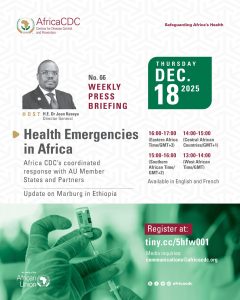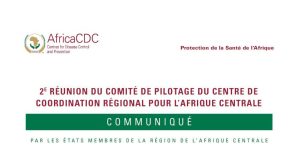Addis Ababa, Ethiopia, 19 November 2021– An interdisciplinary panel of infectious disease clinicians and public health experts led by the Africa Centres for Disease Control and Prevention (Africa CDC) and the Center for Disease Dynamics, Economics & Policy (CDDEP) have released a first edition of the African Antibiotic Treatment Guidelines for Common Bacterial Infections and Syndromes.
Africa Union (AU) Member States and public health stakeholders have identified the lack of locally developed clinical treatment guidelines that define when to treat infections and what appropriate antimicrobial agents to use as a major barrier to providing quality healthcare and mitigating the emergence and spread of antimicrobial resistance (AMR). Except for selected diseases, such as HIV, TB, and Malaria, healthcare providers in Africa have traditionally had to use their individual judgment or rely on guidelines developed outside of Africa to guide the treatment of infectious diseases.
The African Antibiotic Treatment Guidelines for Common Bacterial Infections and Syndromes aim to fill this gap by providing healthcare workers across the African continent with expert recommendations for antimicrobial selection, dosage, and duration of treatment for common bacterial infections and syndromes among pediatric and adult patient populations. The guidelines also aim to promote the appropriate use of antimicrobials to mitigate the emergence and spread of antimicrobial-resistant pathogens.
The guidelines were based on a review of existing national standard or clinical treatment guidelines from AU member states and international organizations, available AMR data, and clinical expertise from physicians, pharmacists, and other healthcare workers involved in the treatment of infectious diseases across more than 15 AU member states. The treatment recommendations are intended to complement existing national and international clinical treatment guidelines, where available, and to provide a template for local adaption in their absence. The guidelines are intended for use by clinicians, nurses, pharmacists, and other personnel involved in the treatment of infectious diseases or dispensing of antimicrobials in Africa.
The guidelines and accompanying quick references guides are available in Arabic, English, French, Portuguese, and Spanish at
1- https://africacdc.org/download/african-antibiotic-treatment-guidelines-for-common-bacterial-infections-and-syndromes-2/
2- https://africacdc.org/download/african-antibiotic-treatment-guidelines-for-common-bacterial-infections-and-syndromes-recommended-antibiotic-treatments-in-adult-patients/
3- https://africacdc.org/download/african-antibiotic-treatment-guidelines-for-common-bacterial-infections-and-syndromes-recommended-antibiotic-treatments-in-neonatal-and-pediatric-patients/
…END…
About Africa CDC
Africa CDC is a specialized technical institution of the African Union established to support public health initiatives of Member States and strengthen the capacity of their public health institutions to detect, prevent, control, and respond quickly and effectively to disease threats.
Learn more at: https://africacdc.org
About CDDEP
The Center for Disease Dynamics, Economics & Policy Inc. (CDDEP) produces independent, multidisciplinary research to advance the health and wellbeing of human populations around the world. CDDEP projects are global in scope, spanning Africa, Asia, and North America, and include scientific studies and policy engagement. The CDDEP team is experienced in addressing country-specific and regional issues, as well as global challenges, such as antibiotic resistance and pandemic influenza. CDDEP research is notable for innovative approaches to design and analysis, which are shared widely through publications, presentations, and web-based programs. CDDEP has offices in Washington, D.C., and New Delhi and relies on a distinguished team of scientists, public health experts, and economists worldwide. Learn more at: www.cddep.org







